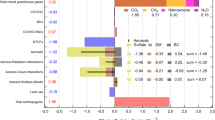Abstract
A case study was performed in Beijing in 2000 to observe concentrations of SO2 and NOx in the atmosphere and to evaluate their radiative impact. It was found that the concentrations of these gases are usually high in the morning due to a temperature inversion in the boundary layer. The average concentrations obtained from the observations are much higher than those used in the McClatchey reference atmosphere. The radiative impacts of these gases are calculated using a line-by-line radiative transfer model. The results show that the radiative forcing at the surface due to SO2 is 0.0576 W m−2 and that due to NOx is 0.0032 W m−2. These figures are almost compatible with that due to CFC11.
Similar content being viewed by others
References
Cope, M., and Coauthors, 2004: The Australian air quality forecasting system. Part I, Project description and early outcomes. Journal of Applied Meteorology, 43, 649–662.
Edwards, D. P., 1992: GENLN2 A general line-by-line atmospheric transmittance and radiance model. National Center for Atmospheric Research (NCAR) Technique Note TN-367+STR, Boulder, Colo., 147pp.
Fuglestvedt, J. S., I. S. A. Isaksen, and W.-C. Wang, 1996: Estimates of indirect global warming potentials for CH4, CO, and NOx. Climatic Change, 34, 405–437.
Johnson, C. E., and R. G. Derwent, 1996: Relative radiative forcing consequences of global emissions of hydrocarbons, carbon monoxide and NOx from human activities estimated with a zonally-averaged two-dimensional model. Climatic Change, 34, 439–462.
Koch, D., D. Jacod, I. Tegen, D. Rind, and M. Chin, 1999: Tropospheric sulfur simulation and sulfate direct radiative forcing in the Goddard Institute for Space Studies general circulation model. J. Geophys. Res., 104, 23799–23822.
Liu Yu, I. S. A. Isaksen, J. K. Sundet, He Jinhai, and Peng Yan, 2004: NOx change over China and its influences. Adv. Atmos. Sci., 21, 132–140.
Manins, P., 2001: Air quality forecasting for Australia’s major cities: Final report. CSIRO Atmospheric Research, Aspendale, 341pp.
McClatchey, R. A., R. W. Fenn, J. E. Selby, F. E. Volz, and J. S. Garing, 1972: Optical properties of the atmosphere. 3rd ed, AFCRL-72-0497, Air Force Cambridge Research Laboratory, Bedford, MA, USA, 113pp. (NTIS N7318412).
Pun, B. K., C. Seigneur, and W. White, 2003: Day-of-week behavior of atmospheric ozone in three U. S. cities. Journal of Air & Waste Management Association, 53(7), 789–801.
Rothman, L. S., and Coauthors, 1998: The HITRAN molecular database and HAWKS (HITRAN Atmospheric Workstation): 1996 editions. Journal of Quantitative Spectroscopy and Radiative Transfer, 60, 665–710.
Shine, K. P., R. G. Derwent, D. J. Wuebbles, and J-J. Morcrette, 1992: Radiative forcing of climate. Chapter 2, Climate Change, The IPCC Scientific Assessment, 41–68.
Smith, R. I., D. Fowler, M. A. Sutton, C. Flechard, M. Coyle, 2000: Regional estimation of pollutant gas dry deposition in the UK: Model description, sensitivity analyses and outputs. Atmos. Environ., 34(22), 3757–3777.
Wang Xiaoyun, Pan Liqing, Lu Weilin, Xuan Chunyi, and Gao Yanhu, 2001: Observational study on relationship between vertical distribution of pollutant gases and meteorological condition at Beijing in winter. Journal of Applied Meteorological Science, 12(3), 279–286. (in Chinese)
Wigley, T. M. L., and S. C. B. Raper, 2002: Reasons for the larger warming projections in the IPCC Third assessment report. J. Climate, 15, 2945–2952.
Wigley, T. M. L., S. J. Smith, M. J. Prather, 2002: Radiative forcing due to reactive gas emissions. J. Climate, 15, 2690–2696.
Zhang Meigen, Xu Yongfu, I. Uno, and H. Akimoto, 2004: A numerical study of tropospheric ozone in the spring-time in East Asia. Adv. Atmos. Sci., 21, 163–170.
Zhou Li, Xu Xiangde, Ding Gouan, Zhou Mingyu, and Cheng Xinghong, 2005: Diurnal variation of air pollution and atmospheric boundary layer structure in Beijing during winter 2000/2001. Adv. Atmos. Sci., 22, 126–132.
Author information
Authors and Affiliations
Rights and permissions
About this article
Cite this article
Sun, Z., Wang, X. & Zeng, X. Radiative forcing of SO2 and NOx: A case study in Beijing. Adv. Atmos. Sci. 23, 317–322 (2006). https://doi.org/10.1007/s00376-006-0317-6
Received:
Revised:
Issue Date:
DOI: https://doi.org/10.1007/s00376-006-0317-6




